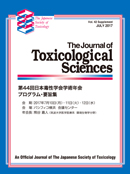The 48th Annual Meeting of the Japanese Society of Toxicology
Displaying 51-100 of 419 articles from this issue
Symposium 9
-
Session ID: S9-1
Published: 2021
Released on J-STAGE: August 12, 2021
Download PDF (28K) -
Session ID: S9-2
Published: 2021
Released on J-STAGE: August 12, 2021
Download PDF (134K) -
Session ID: S9-3
Published: 2021
Released on J-STAGE: August 12, 2021
Download PDF (127K) -
Session ID: S9-4
Published: 2021
Released on J-STAGE: August 12, 2021
Download PDF (132K)
Symposium 10
-
Session ID: S10-1
Published: 2021
Released on J-STAGE: August 12, 2021
Download PDF (128K) -
Session ID: S10-2
Published: 2021
Released on J-STAGE: August 12, 2021
Download PDF (139K) -
Session ID: S10-3
Published: 2021
Released on J-STAGE: August 12, 2021
Download PDF (116K) -
Session ID: S10-4
Published: 2021
Released on J-STAGE: August 12, 2021
Download PDF (116K)
Symposium 11
-
Session ID: S11-1
Published: 2021
Released on J-STAGE: August 12, 2021
Download PDF (98K) -
Session ID: S11-2
Published: 2021
Released on J-STAGE: August 12, 2021
Download PDF (106K) -
Session ID: S11-3
Published: 2021
Released on J-STAGE: August 12, 2021
Download PDF (105K) -
Session ID: S11-4
Published: 2021
Released on J-STAGE: August 12, 2021
Download PDF (115K)
Symposium 12
-
Session ID: S12-1
Published: 2021
Released on J-STAGE: August 12, 2021
Download PDF (122K) -
Session ID: S12-2
Published: 2021
Released on J-STAGE: August 12, 2021
Download PDF (126K) -
Session ID: S12-3
Published: 2021
Released on J-STAGE: August 12, 2021
Download PDF (110K) -
Session ID: S12-4
Published: 2021
Released on J-STAGE: August 12, 2021
Download PDF (102K) -
Session ID: S12-5
Published: 2021
Released on J-STAGE: August 12, 2021
Download PDF (137K)
Symposium 13
-
Session ID: S13-1
Published: 2021
Released on J-STAGE: August 12, 2021
Download PDF (130K) -
Session ID: S13-2
Published: 2021
Released on J-STAGE: August 12, 2021
Download PDF (101K) -
Session ID: S13-3
Published: 2021
Released on J-STAGE: August 12, 2021
Download PDF (117K) -
Session ID: S13-4
Published: 2021
Released on J-STAGE: August 12, 2021
Download PDF (94K)
Symposium 14
-
Session ID: S14-1
Published: 2021
Released on J-STAGE: August 12, 2021
Download PDF (44K) -
Session ID: S14-2
Published: 2021
Released on J-STAGE: August 12, 2021
Download PDF (119K) -
Session ID: S14-3
Published: 2021
Released on J-STAGE: August 12, 2021
Download PDF (97K) -
Session ID: S14-4
Published: 2021
Released on J-STAGE: August 12, 2021
Download PDF (120K)
Symposium 15
-
Session ID: S15-1
Published: 2021
Released on J-STAGE: August 12, 2021
Download PDF (125K) -
Session ID: S15-2
Published: 2021
Released on J-STAGE: August 12, 2021
Download PDF (106K) -
Session ID: S15-3
Published: 2021
Released on J-STAGE: August 12, 2021
Download PDF (108K) -
Session ID: S15-4
Published: 2021
Released on J-STAGE: August 12, 2021
Download PDF (115K)
Symposium 16
-
Session ID: S16-1
Published: 2021
Released on J-STAGE: August 12, 2021
Download PDF (117K) -
Session ID: S16-2
Published: 2021
Released on J-STAGE: August 12, 2021
Download PDF (139K) -
Session ID: S16-3
Published: 2021
Released on J-STAGE: August 12, 2021
Download PDF (131K) -
Session ID: S16-4
Published: 2021
Released on J-STAGE: August 12, 2021
Download PDF (119K) -
Session ID: S16-5
Published: 2021
Released on J-STAGE: August 12, 2021
Download PDF (155K)
Symposium 17
-
Session ID: S17-1
Published: 2021
Released on J-STAGE: August 12, 2021
Download PDF (119K) -
Session ID: S17-2
Published: 2021
Released on J-STAGE: August 12, 2021
Download PDF (91K) -
Session ID: S17-3
Published: 2021
Released on J-STAGE: August 12, 2021
Download PDF (119K) -
Current situation of environmental risk assessment and efforts to develop eco-friendly agrochemicalsSession ID: S17-4
Published: 2021
Released on J-STAGE: August 12, 2021
Download PDF (119K) -
Session ID: S17-5
Published: 2021
Released on J-STAGE: August 12, 2021
Download PDF (127K) -
Session ID: S17-6
Published: 2021
Released on J-STAGE: August 12, 2021
Download PDF (108K)
Symposium 18
-
Session ID: S18-1
Published: 2021
Released on J-STAGE: August 12, 2021
Download PDF (141K) -
Session ID: S18-2
Published: 2021
Released on J-STAGE: August 12, 2021
Download PDF (105K) -
Session ID: S18-3
Published: 2021
Released on J-STAGE: August 12, 2021
Download PDF (126K) -
Session ID: S18-4
Published: 2021
Released on J-STAGE: August 12, 2021
Download PDF (36K)
Symposium 19
-
Session ID: S19-1
Published: 2021
Released on J-STAGE: August 12, 2021
Download PDF (58K) -
Session ID: S19-2
Published: 2021
Released on J-STAGE: August 12, 2021
Download PDF (526K) -
Session ID: S19-3
Published: 2021
Released on J-STAGE: August 12, 2021
Download PDF (529K) -
Session ID: S19-4
Published: 2021
Released on J-STAGE: August 12, 2021
Download PDF (54K) -
Session ID: S19-5
Published: 2021
Released on J-STAGE: August 12, 2021
Download PDF (104K)
Symposium 20
-
Session ID: S20-1
Published: 2021
Released on J-STAGE: August 12, 2021
Download PDF (106K)
